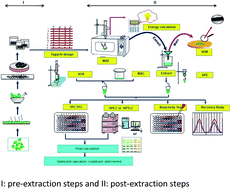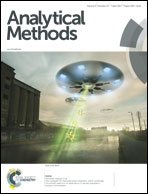Strategizing method optimization of microwave-assisted extraction of plant phenolics by developing standard working principles for universal robust optimization
Abstract
This article is focused on making the optimization of microwave-assisted extraction (MAE) of phenolics from leaves easier by proposing some basic check points or riders which will provide help for beginners and industries in the quick adoption of such technologies for the large scale extraction of nutraceuticals. The Taguchi L9 model was used for the optimization of the MAE conditions for phenolic extraction from the leaves of Taraxacum officinale. Total phenolic content was used as the performance monitoring parameter for the proposed extraction model. The study reports 160 W microwave power, 6 min extraction time, 80 °C temperature and 10 min preleaching time as the optimized MAE conditions. Kinetic plot mapping, checks for chromatogram matching, SEM studies, bioactivity profiling, nutraceutical profiling, degradation profiling and environmental impact studies were the other supporting parameters used for arriving at the different check points proposed in this article. Rutin, naringenin, chlorogenic acid, ellagic acid, gallic acid, luteolin, quercetin and ferulic acid were the standard phenolics/flavonoids that were identified in the extract through HPTLC. The efficiency of MAE in terms of TPC was found to be more than 60% higher than that observed by Soxhlet extraction, with significant improvement in nutraceutical content and bioactivity as evaluated through total antioxidant capacity and anti-inflammatory activity.



 Please wait while we load your content...
Please wait while we load your content...